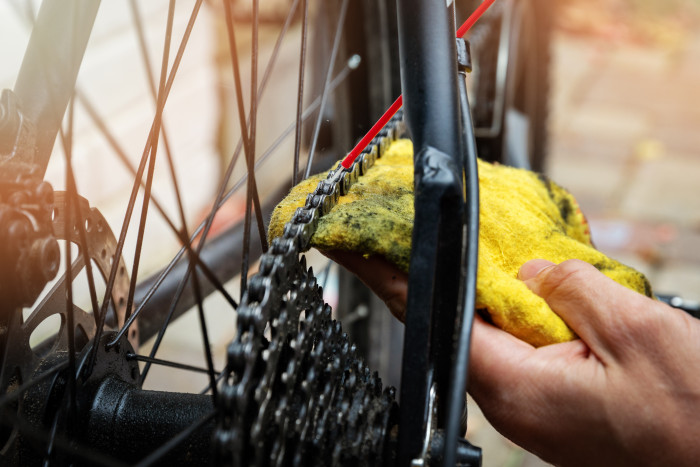
Preparing Your Bike for Winter
As the days grow shorter and the temperature drops, cycling through the winter months can be tough on both you and your bike. Winter conditions such as moisture, dirt, and road salt can accelerate wear and tear, while the cold can make materials more brittle, increasing the risk of damage.
So here’s our top tips to winter-proof your bike and gear up for the chilly season.
1. Essential Winter Maintenance
Winter conditions are harder on bikes due to moisture, salt, and grime, so maintaining key components is crucial.
- Lubricate the Chain: Switch to a wet lube designed for rainy or snowy conditions. Wet lubes are thicker, creating a protective layer that helps prevent rust, but they also attract more dirt, so clean your chain regularly.
- Inspect Brake Pads: Winter brings more grit and debris, which wears down brake pads faster. Check them before winter sets in and replace them if necessary. Consider switching to pads designed for wet conditions for improved stopping power.
- Check Your Tyres: Slick or bald tyres are dangerous in winter. Opt for tyres with deeper tread or even winter-specific tyres, which provide better grip on wet, icy, or muddy roads. Ensure they’re properly inflated, but remember that slightly lower pressure can improve traction in slippery conditions.
2. Winter-Specific Gear
Winter gear for your bike is just as important as the thermal layers you’ll also be digging out!
- Mudguards: Fitting full-length mudguards will protect you and your bike from road spray. They help keep grit and water off your drivetrain, reducing wear and tear, and keep your clothes much cleaner!
- Winter Tyres: If you frequently ride in areas prone to ice, consider winter tyres with extra grip or studded tyres for extreme conditions. These offer better control and reduce the risk of sliding on black ice.
- Lighting: With reduced daylight, good-quality lights are essential. Invest in a bright front light and a rear light with multiple modes for visibility in different conditions. Make sure you carry spare batteries or a portable charger if your lights are USB rechargeable.
3. Adjusting Your Riding Style
Riding in winter means some adjustments are needed to stay safe.
- Slow Down: Wet roads, leaves, and frost can create slippery surfaces. Reduce your speed, especially when cornering, and give yourself more time to stop by braking earlier than usual.
- Be Aware of Ice: Black ice is a real danger in winter. Stick to well-gritted roads where possible, and avoid cycling early in the morning when ice is most likely. If you do encounter an icy patch, avoid braking or turning abruptly—stay as straight and steady as possible.
- Be Predictable: In winter, visibility is often poor due to rain, fog, or low light. Make sure to signal your turns early and ride in a consistent, predictable manner to give drivers time to react.
4. Clothing & Accessories
Staying warm and dry is kind of important for enjoying winter rides, and the right clothing will make all the difference.
- Layering is Key: Start with a moisture-wicking base layer to keep sweat off your skin, then add an insulating layer and a waterproof, windproof jacket. Look for jackets with reflective details to increase visibility.
- Gloves and Overshoes: Cold hands and feet can quickly turn a ride miserable. Invest in some insulated, waterproof gloves and overshoes to keep your hands and feet warm and dry.
- Neck Warmers & Hats: A thin hat that fits under your helmet and a neck warmer or buff can provide extra warmth without adding too much bulk.
5. Storing Your Bike Safely in Winter
Storing your bike properly during winter will help protect it from the elements and also theft.
- Indoor Storage: Whenever possible, store your bike indoors in a dry, well-ventilated space to prevent rust and corrosion. If indoor storage isn’t possible then use a waterproof cover to protect your bike from rain and snow.
- Keep It Elevated: If your bike must be stored outside, ensure it’s elevated off the ground to avoid pooling moisture. This helps reduce the risk of rust forming on metal components.
- Secure Your Bike: Always lock your bike securely with a sturdy ‘Sold Secure’ gold lock or above, even when stored at home. For extra security, remove easily detachable parts like lights or the seat post if your bike is left outside for extended periods.
6. Ongoing Maintenance
Winter riding requires more frequent maintenance to keep your bike in tip-top shape.
- Clean Your Bike Regularly: After a wet or muddy ride, clean your bike as soon as possible. Use a hose or bucket of water to wash off grit, then dry the bike and re-lubricate the chain. This prevents rust and keeps components functioning smoothly.
- Inspect Moving Parts: Salt from gritted roads can corrode metal parts, so pay extra attention to your drivetrain, brakes, and derailleurs. Wipe them down and check for signs of wear more often than you would in summer.
- Brake and Gear Cables: Wet weather can cause cables to rust or stick. Regularly check your brake and gear cables for smooth operation and replace them if you notice any stiffness or rust.
So as you dig out your winter woolies to prepare yourself for the colder weather, these tips will also make sure your 2-wheeled friend is also ready for your winter cycling adventures together!
